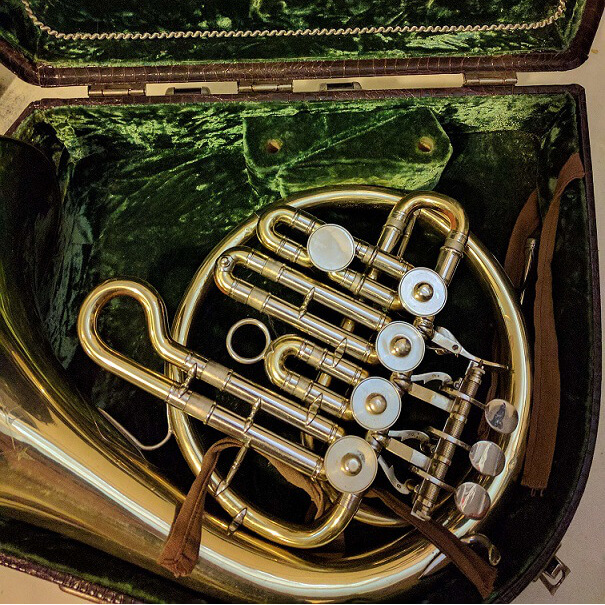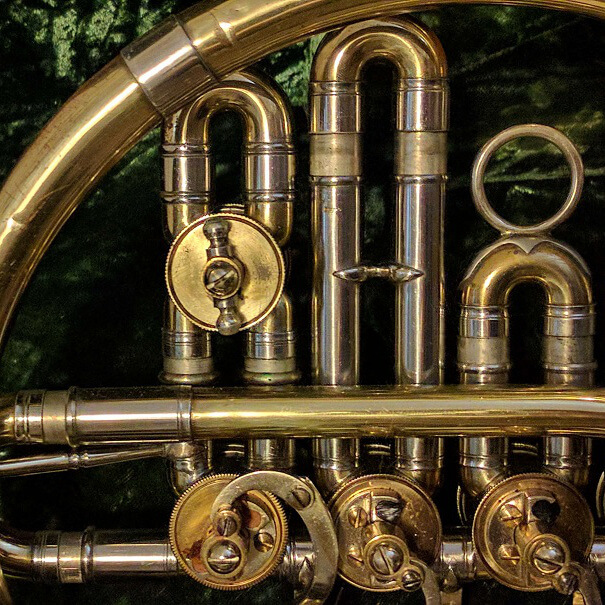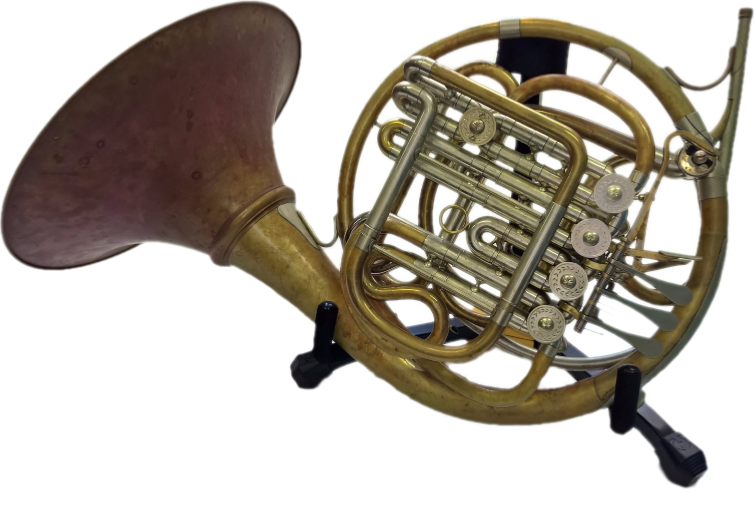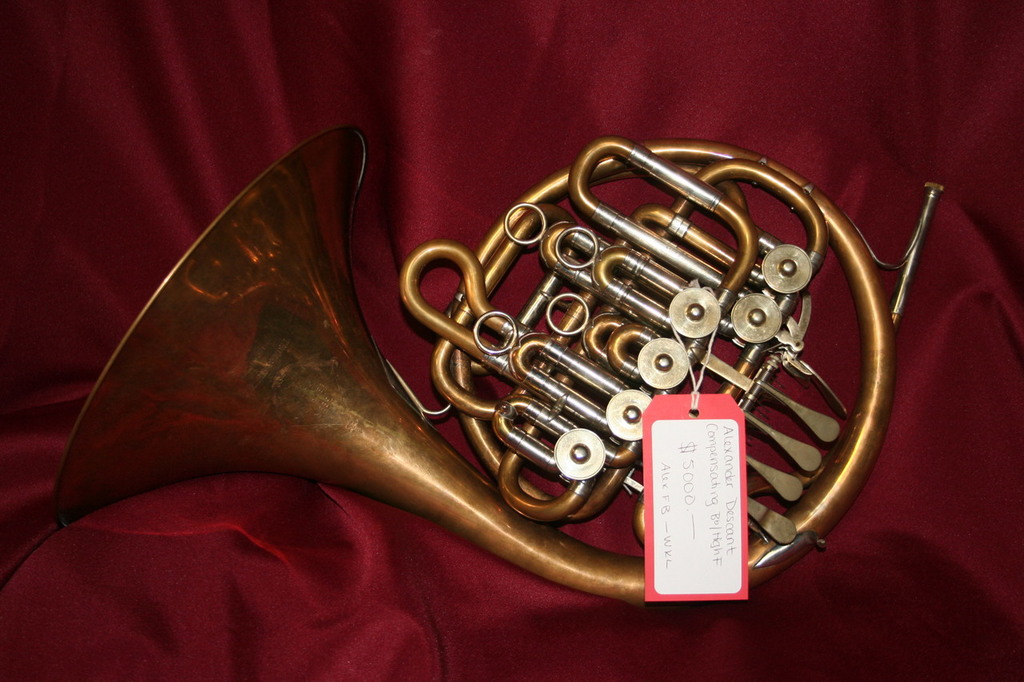- The biggest WEAKNESS of Fingering Charts
- Single F Horn Fingering Chart
- Single Bb Fingering Chart
- Double (F/Bb) Fingering Chart
- F-alto/Mellophone Fingering Chart
- Double Descant (Bb/f) Fingering Chart
- Triple Horn Fingering Chart
I get quite a few questions about French horn fingering charts (both online and in lessons and sectionals) I wanted to create a page to hopefully reduce some of the mystery of French horn fingerings for all the different types of French horns.
This page has fingering charts for all sorts of horns, including:
- Single F, Bb, and F alto horns
- Double horns
- Double descant horns
- Triple horns
As well as information about the hidden problem with all fingering charts – especially for younger players!
French Horn Fingering Charts – Strengths and Weaknesses
The biggest issue with these charts is what they don’t show.
While all these charts show recommended fingerings for each note, they don’t give you all the possibilities.
To see all the note possibilities for a double horn (or single F/Bb), you need something different. You need something like my harmonic series sheet. This chart shows you the partials (or harmonics) for every fingering on a double horn. All possible notes are shown!
Note that no matter the fingering, the interval pattern (octave, fifth, fourth, major third, etc) is the same. This is called the overtone or harmonic series, and it’s the basis for every brass instrument.
You will see that some notes have numbers underneath them. These numbers show that a particular harmonic will be flat (shown by the “-” sign) or sharp (shown by the “+” sign). The number denotes cents from equal temperament (there are 100 cents in a half-step).
Here’s why it’s so important to know your harmonic series:
Take a look at the line for an open F horn (in the middle of the page, labeled “F 0”. You can see that you have all the expected open notes but if you look between the 6th and 8th harmonics, you’ll see something unexpected. This 7th harmonic Bb is a “hidden” note – its pitch is very flat, so Bb is almost never played open – but it’s there.
If you’re slurring a C major arpeggio, you must use extra caution (and airspeed) between that G and C to skip over the Bb.
If you look up and down the chart, you’ll see that this flat 7th partial is present on every line, and in each case, this note/fingering combination doesn’t appear on standard fingering charts.
Now take a look at the third line (Bb 1). Notice the note between the 6th and 8th partials, and think about the opening to the 2nd movement of Mozart’s 3rd horn concerto. Knowing that there is a “hidden” note between those two notes suddenly makes the slur a whole lot easier!
Single F Horn Fingering Chart
The F horn fingering chart has a couple of uses.
The first, and most obvious, is if you’re playing on a single F horn. You’ll need to know these fingerings.
However, even if you are playing a double horn, you should still memorize at least the two octaves from G below to G above the staff. The reason, of course, is for hand-stopping.
As you probably know, the general rule for stopped horn is to finger notes one-half step lower than normal on the F side. To do this, you obviously need to know all of your F horn fingerings!
On my F horn fingering chart, the most commonly used fingering is given first, and optional fingerings are given in parenthesis. Note that not every fingering is listed on my chart – I don’t have the 7th or 11th partials listed, since they are not regularly used.
Single Bb Horn Fingering Chart
Like the F horn fingering chart, even if you play on a double horn, it’s a good idea to know all your Bb horn fingerings. Not only are there some very useful alternate fingerings, but if you end up playing a single Bb marching horn, you’ll need them!
Standard Bb single horns generally have 4-valves, the three “main” valves, and a thumb key for a ¾ tone stopping valve (halfway in length between the 1st and 2nd valve slides). The stopping valve allows you to play notes on the Bb horn without transposing, using regular fingerings (plus the stopping valve).
However, some Bb horns have an A/stop thumb valve (which makes playing in certain keys easier), while others also have an F-extension (which adds about 3 feet of tubing to make open F horn notes easier to play).
These extra valves may be combined (A/stop valves are common, with the valve function determined by the slide pull, or a combined A/stop/F extension with the manual turn valve) or separate (A/stop valve controlled by the thumb, while the F extension is either an additional thumb key or a pinky key).
Keep in mind also that while the F-extension allows you to play open F-horn notes, the three “main” valves are not long enough to use standard F horn fingerings, so while you can use them to get some lower notes than you could otherwise obtain, you can’t use normal F horn fingerings.
Keep in mind that my fingering chart assumes that your horn has both an F extension and stopping valve and that the F extension and stopping valve are separate. If they are combined, then the fingering F+ (F extension and stopping valve) is not possible, and notes that use that fingering combination are will need to use a different combination or are unavailable.
Double F/Bb Horn Fingering Chart
This is similar to my single F fingering chart since the primary fingering(s) are given first, with commonly-used options given in parenthesis.
This chart assumes that your double horn “sits” in F (that is, you press down on the thumb valve for the Bb horn), and “T” denotes using the trigger to switch to the Bb horn.
Generally speaking, you’ll switch from the F horn to the Bb horn on the second space Ab (or G#) in the treble clef. However, there are some notes in the lower register (especially low D and Db) that work much better on the Bb horn. As you become more comfortable with Bb horn fingerings in the mid and low register, you may also find certain technical lines work better on the Bb horn.
Like the F horn fingering chart, while there are commonly-used alternative fingerings listed, these are not comprehensive. To see all possible harmonics for a double horn use my harmonic series chart.
Single F alto/Mellophone Fingering Chart
The fingerings for a single F-alto horn and mellophone are the same since they are essentially the same instrument with a different wrap and tapers.
Be aware that F alto horns (as well as descant and triple horns) are very sensitive to right-hand position, and a lazy or out-of-place right hand will cause major intonation inconsistencies on these instruments.
These instruments are also sensitive to mouthpiece selection. Using a large-bore mouthpiece on an F alto horn, or using a French horn mouthpiece with an adapter on a mellophone can cause intonation issues. That being said, I encourage the use of regular horn mouthpieces on a mellophone, for ease of switching back to the “real” horn.
While most single F-alto horns are traditional, three-valve instruments, there are some that include thumb keys.
I have an Alexander F alto with a thumb valve that has a half-step or ¾ tone setting. Setting it to ¾ of a tone, and depressing all the valves will give you the harmonic series of an open Bb horn. I haven’t seen this feature on other F alto horns, although some do have Bb extensions in the same way they Bb horns have F extensions.
Generally, F alto horns don’t need stopping valves. This is because lots of repertoire that uses a single F alto horn doesn’t require hand-stopping, and the transposition for F alto stopping is relatively easy – finger notes one whole step lower (as opposed to a half step for the normal length F horn).
Double Descant Bb/F alto Fingering Chart
Finding good fingering charts for these horns can be a bit trickier since there are so many different versions of these horns.
Like Bb horns, double descants can have an A-extension, a stop valve, an F-extension, or any combination of these. Many times descants that have all these will have them combined into one valve, so it’s not always possible to use them completely independently, like with the single Bb horns mentioned above. Having the F alto horn does give you some more options in the lower register, though.
Additionally, note that while most descant horns have stopping valves, these only work on the Bb side of the instrument. This is because hand stopping on the high F side requires the relatively easy whole step down transposition (as opposed to the half step for the regular F horn)
Similarly, the F extension only works on the Bb side of the horn and while you can come up with some creative fingerings for the low register, they won’t be the same as regular F horn fingerings.
A 5-valve descant generally features two thumb valves (one for the Bb/F alto change valve, the other for the A/stop/F-extension), while a 6 valve descant (which usually has a separate A/stop valve and F extension) often has two thumb valves and an additional valve for the left-hand pinky.
Needless to say, these fingering charts can be very complex and confusing. They rely on the player to discover the ins and outs of a particular instrument.
Note that, like my single Bb fingering chart, I assume that your horn has a separate F extension and stopping valve. If they are a single valve, then the fingering F+ (F extension plus stopping valve) isn’t possible and notes that use that fingering need to use an alternate fingering or are unplayable.
Triple Horn F/Bb/F alto Fingering Chart
The triple horn, being a relatively new design (at least from a practical standpoint), doesn’t yet have the standardization of fingerings that the double horn (or even double descant) has.
I think part of the reason for this is the wide range of triple horn designs and quality. The different valve layouts and taper configurations can cause different models to play drastically differently. The triple horn is all about compromises, and different compromises mean different preferred fingerings.
Additionally, some triple horn models have F alto sections, while some (most notably Englebert Schmid) use Eb alto for the highest horn. The Eb alto idea does have some advantages, but many players (myself included) still prefer the F alto horn. Since I’m not very familiar with the Eb alto horn, I use F alto fingerings for my chart.
On my particular instrument (a Paxman 75M) I use the F alto side as more of a color/timbre shift than a high-note option. Similarly, sometimes I like to use the low F side quite a bit from third space C to high G for a specific tonal color.
On my horn, I find the F alto side is great for lighter tone colors, while the low F side has a nice, slightly brassy character when pushed. The Bb horn is somewhere in the middle of the two.
There are many makers of triple horns that strive to match the horns so that they all play and sound the same (at least, as much as possible). This is certainly a valid philosophy, but I don’t think that any maker has gotten it 100% right.
If you’re going to play a triple horn, there are going to be compromises. It’s important that you are aware (and okay) of them before buying.
In the interest of completeness, I’ve tried to include as many practical fingerings for all three horns as space permits. This way you can discover what works best for your specific instrument and make your own fingering chart!
Need More Help With Fingerings?
You can always get in touch with me using one of the methods on my contact page. Additionally, I offer horn lessons both in-person and online for all levels of students!







